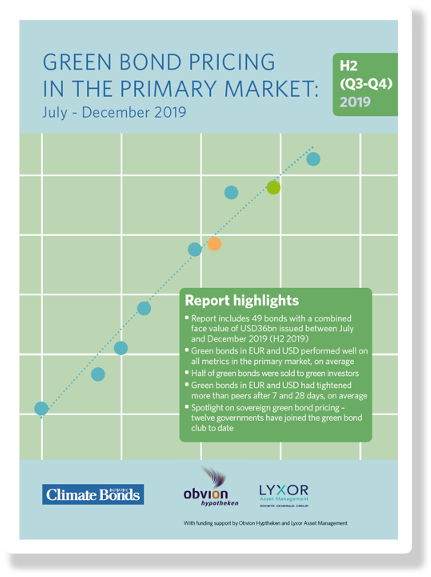
Greenium, Sovereign Green and Investor Demand Mark 2nd Half of 2019
 |
We continue with our series of “Green Bond Pricing in the Primary Market” reports with the release of the 9th iteration. The latest report monitors the performance of 36 EUR and 13 USD denominated benchmark size green bonds with a total value of USD36bn issued during H2 2019. This is the 9th report, and the fourth semi-annual report, marking the period July-December 2019. Prior to 2018, reports were released every quarter, the first one being the Q4 2016 Snapshot.
|
Highlights from Q3-Q4 2019 - Greenium Emerges for 16 of 19 Bonds
- 36 EUR and 13 USD labelled green bonds issued in H2 2019 were analysed
- Green bonds achieved larger book cover and greater spread compression than vanilla equivalents on average
- Yield curves were built for 19 green bonds in our sample. Just three priced with a normal new issue premium. The remainder priced either on their yield curves or with a greenium
- Half of the green bonds were allocated to investors declaring themselves green
- Seven and 28 days after pricing, green bonds had, on average, tightened by more than matched indices and baskets of bonds sharing similar characteristics
- Lyxor launched a second green ETF: The Lyxor Green Bond ESG Screened fund, bringing the total number of green bond ETF products to six
Spotlight on Sovereign Green Bond Pricing
- Twelve governments have joined the sovereign green bond club to date issuing a total of 19 green bonds to date
- Eleven more governments have committed to green issuance during 2020/2021
- Sovereign green bonds are well understood, frequently issued, products that can bring scale to the market through benchmark pricing, liquidity and precedent
- The results of our Green Bond European Investor Survey from November 2019 highlighted a lack of supply in all types of green bonds
- Sovereigns and non-financial corporates were the two asset classes in which institutional investors stated they particularly wanted to buy more green bonds
Detailed Findings
This research encompasses about a third of green bonds issued in H2 2019. Thirty qualifying issuers revisited the green bond market, while 17 issued green bonds for the first time. Most (13) of the first-time issuers were financial corporates.
EUR and USD green bonds performed well during book building and on average, attracted larger book cover and experienced greater spread compression compared to vanilla equivalents.
Yield curves were built for 19 qualifying bonds and only three of those bonds priced with the normal new issue premium. The remainder either priced on the curve or with a greenium.
Green bonds attract interest from a growing number of investors and on average, half of the green bonds in our sample were allocated to investors describing themselves as green. No investor has a reason to avoid green bonds as they are not excluded from any of the broad market bond indices.
Seven and 28 days after pricing green bonds had, on average, tightened more than vanilla baskets and matched indices suggesting that the momentum gained during book building extends into the immediate secondary market.
Lyxor launched its second green bond ETF, the Lyxor Green Bond ESG Screened fund, bringing the total number of green bond ETF products to six. We are monitoring the growth of these passive investment vehicles and note that the growth in some of the green bond ETF has been quite remarkable.
In Summary
H2 2019 was another strong period for green bonds with opportunities for both issuers and investors. The results of this analysis indicate that the demand for green bonds remains robust.
On average, both EUR and USD green bonds achieved higher book cover and greater spread compression than vanilla equivalents. Yield curves were only available for 19 bonds, but only three of those exhibited a normal new issue premium. The remainder either priced with a greenium or flat to the curve.
Half of the green bonds in our sample were allocated to investors describing themselves as green.
Green bonds are included in all broad market benchmarks so mainstream investors are also motivated to buy them. In the immediate secondary market, green bonds tightened by a greater magnitude on average than either matched baskets of vanilla bonds or corresponding indices.
We will continue tracking pricing trends as the market moves into the hundreds of billions.
The Last Word from Sean Kidney
“The report notes greenium emerging in some issuance and continuing strong investor demand for green sovereigns. These two factors should help shape market & investor directions and encourage a strong green component in stimulus programs.”
Keep an eye out for our next update covering what is now a tumultuous Q1-Q2 (H1) of 2020, due for publication in September 2020.
‘Till next time,
Climate Bonds.
Download the Green Bond Pricing in the Primary Market H2-2019 report here and all the previous Pricing reports are available here.
Methodology notes: Climate Bonds uses yield on the issue date, which reflects the price that the green bond offered on the pricing date. For comparable bonds, we use the yield-to-convention-mid.
For all bonds, we use modified duration to mid, and all the data is as of the pricing date of the green bond. The modified duration is the percentage price change of a security for a given change in yield. The modified duration increases with risk.
First, we plot seasoned vanilla bonds (blue dots) and fit a 2nd order polynomial yield curve. Next, we overlay any seasoned green bonds (orange), and finally, we add our subject bonds (green). We include the yield curves of bonds in our sample with a minimum of four suitable comparable bonds.
Comparable bonds used for this exercise must fit the specification for green bond selection outlined on page 21, except that the use of proceeds is not limited. Bonds must share the same credit rating and payment rank as the green bond and have been issued on or after 01/01/2010.
